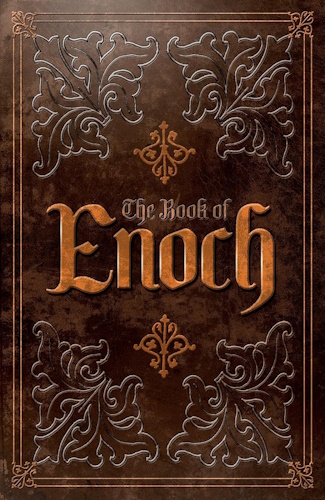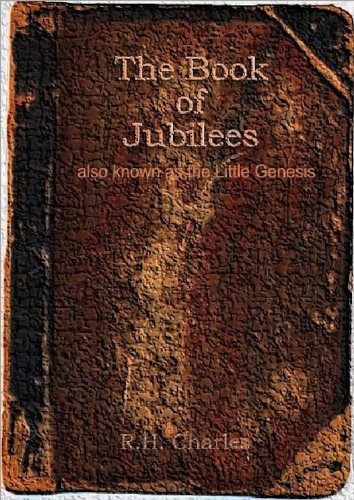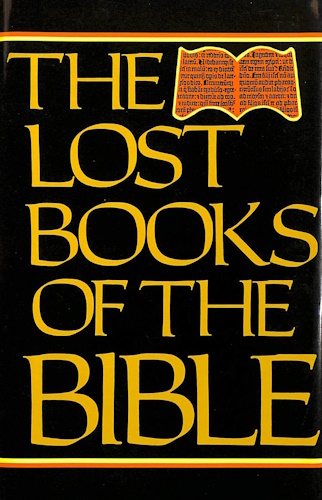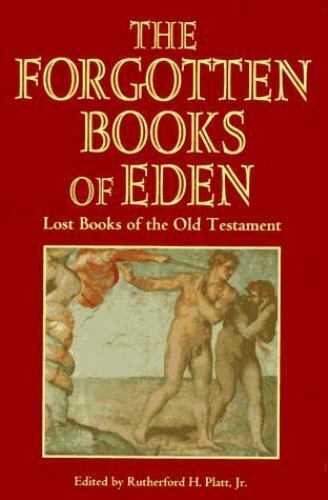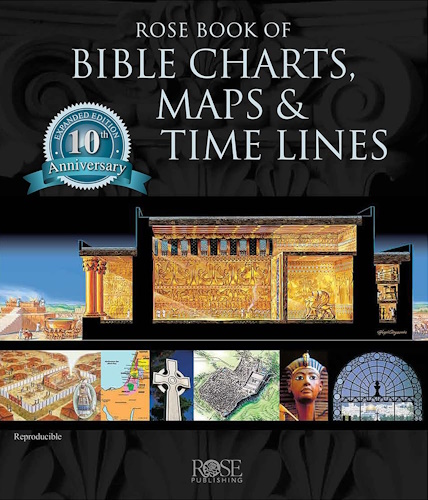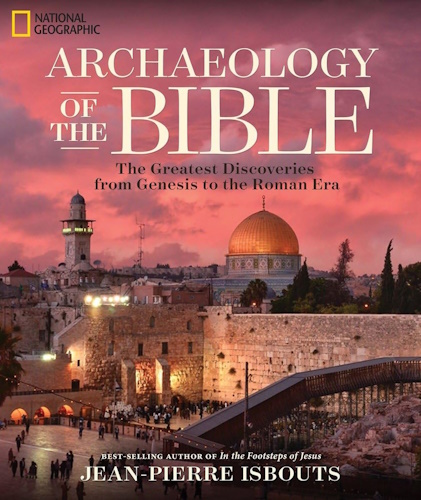
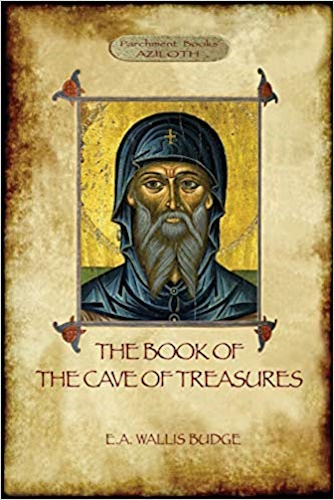
The Book Of The Cave Of Treasures
A History Of The Patriarchs And The Kings
Their Successors From The Creation
To The Crucifixion Of Christ
by
Sir E.A. Wallis Budge, KT.
M.A., LITT.D. (CAMBRIDGE), M.A., D.LITT. (OXFORD),
D.LIT. (DURHAM), F.S.A.
![]()
![]()
p. 168
[THE FIFTH THOUSAND YEARS. FROM THE TWENTY-SIXTH YEAR OF EHUD'S LIFE TO THE SECOND YEAR OF THE REIGN OF CYRUS.]
Nâbhîn (Jabin), who was dried up in body, ruled twenty years.
Deborah and Barak [ruled them] forty years. The children [Fol. 30b, col. 2] of Israel were in subjection to the Midianites seven years, and God delivered them by the hands of Gideon, who ruled them forty years.
Abimelech his son reigned after him three years.
Tûla` (Tola), the son of Puah [ruled them] twenty-three years.
Yâîr, the Gileadite, twenty-two years.
And again the children of Israel were in subjection to the Ammonites eighteen years, and God delivered them by the hand of Naphtah (Jephthah), the man who offered up his daughter as a sacrifice, and he ruled them six years.
Abhîsân (Ibzan of Bethlehem), who is Nahshôn (sic), ruled them seven years.
p. 169
Alôn (Elon), who was from Zebulon, ruled them ten years.
`Abhrôn (Abdon, the son of Hillel, the Pirathonite) ruled them eight years.
And the children of Israel were in subjection to the Philistines forty years, and God delivered them by the hand of Samson, and he ruled them twenty years.
And the [Fol. 31a, col. 1] children of Israel lived without a governor for eighteen years, and then Eli the priest rose up and ruled them forty years.
And Samuel rose up over them and ruled them twenty years. And in the days of Samuel the children of Israel provoked to wrath God, Who had delivered them from the servitude of the Egyptians, and they made Saul, the son of Kish, king, and he reigned over them forty years.
And in the days of Saul lived Gûlyâdh (Goliath), a giant of the Philistines. He came nigh and reviled Israel, and blasphemed against God, and David, the son of Jesse, killed him. And David was praised in songs by the daughters of Israel, and Saul persecuted him. And the Philistines slew Saul because he forsook the Lord, and took refuge with the devils.
[NOTE.--The story of David and Goliath finds an interesting parallel in the history of Sanehat
p. 170
as found in an Egyptian papyrus in the Royal Library at Berlin. Sanehat fled from Egypt as the result of some political trouble, and made his way into Palestine, where he settled down and prospered, and became a shêkh of great influence and importance. Then a certain man of Thennu went to Sanehat's tent and reviled him, and challenged him to fight him. This man was a mighty warrior, and was famed throughout the country for his strength, and valour, and success. During the following night Sanehat made ready his dagger, and spear, and bow, and at daybreak all the tribes came to the place to witness the great duel which was to take place. The man of Thennu grasped his shield and his battle-axe, and then began to hurl his spears at Sanehat, but they either went wide or Sanehat managed in some way to avoid them; in any case, they failed to touch him. When the man of Thennu saw this, he lost his temper, and made a rush at Sanehat, meaning to close with him and despatch him with his battle-axe. But as he came on in his mad rage Sanehat hurled his short javelin at his head, and it pierced his neck and remained fast in it. The man of Thennu uttered a prolonged shriek and then fell headlong on the ground, face downwards. Sanehat went to him, and, taking his foe's weapons from him, killed him with them. Then
p. 171
he took his stand on the dead body, and shouted the cry of victory, and the onlookers rejoiced in his triumph and applauded him.]
David reigned over [Fol. 31a, col. 2] the children of Israel forty years, and Solomon, his son, reigned forty years.
And Solomon did great and wonderful things, and it was he who sent to Ophir and brought gold from the mountains of gold, and the ships sailed the sea for thirty-six months, and then came forth (i.e. returned). It was he who built Tadmor (Palmyra) in the wilderness, and he carried out there great and wonderful works. And when Solomon passed the borders of the mountain which is called Sâ`êr, he found there the altar which Pîôrzâkhâr, and Pîôrzânâi, and Neznâdhôr had built. These were they whom Nimrod, the giant, sent to Balaam, the priest of the Mountain of Sâ`êr, because he heard that he was wont to consult the Signs of the Zodiac, and when they were passing the skirts of the mountain they built there an altar to the sun. And when Solomon saw it he built a city there and called its name "Nîâpôlîs " (more correctly, Heliopolis) [Fol. 31b, col. 1], that is to say, "City of the Sun." And Solomon also built Aradus (Arvad) in the midst of the sea, and he became so famous and renowned
p. 172
that the report of his wise acts went out into all the ends of the earth. And the Queen of Sheba went to hold converse with him. And Solomon loved Hiram, king of Tyre, greatly. And Hiram reigned in Tyre five hundred years, from the days of the kingdom of David to the [days of] the kingdom of Zedekiah and of all the kings of the children of Israel. And at length he forgot that he was a man, and he blasphemed and said, "I am God, and I sit upon the throne of God in the middle of the sea." And Nebuchadnezzar the king killed him.
[NOTE.--Solomon reigned over his large kingdom with the greatest wisdom ever found. But he did not keep his soul; but inclined his heart to the love of women, and forsook God, Who had created him and given him his kingdom. And he died in his denial of Him, and in his sins. Book of Adam (iv. 8.)]
[The purple linen of Tyre.]
And in the days of Hiram the purple-[coloured] apparel worn by kings [first] appeared. As a dog was running along the sea-shore [at Tyre] he saw a purple shell-fish (i.e. the murex) coming up out of the [Fol. 31b, col. 2] water, and he bit it, and straightway his mouth was filled with the blood of that shell-fish. And a certain
p. 173
shepherd who saw the dog brought a piece of woollen cloth and wiped the dog's mouth with it. And he made that piece of woollen cloth into a crown (i.e. a kafîyah or head-cloth), and set it upon his head, and as he walked along in the sun, those who saw him thought that rays of fire were coming forth from his head, and when Hiram heard [of this] he sent for the man. And when he saw the woollen cloth he marvelled, and was astonished. And all the dyers gathered together and marvelled at it, and they set out to enquire into the matter; and they found some of these shell-fish and rejoiced greatly.
[The Apostasy of Solomon.]
And Solomon waxed exceedingly great. And the food [provided for his table every day] consisted of forty oxen, one hundred head of sheep, thirty measures of fine flour, sixty measures of wheat, and three hundred measures of wine; and besides all this [Fol. 32a, col. 1], stags, and gazelle, and wild antelopes, and other creatures of the desert. And he became froward and transgressed the Law, and hearkened not to the commands of his father, and he took to wife one thousand women from all the peoples whom God hated. And in the time of his old age he gave himself up to women, and he let them play with him, and he hearkened to their words, and did
p. 174
their will. And he denied the God of David, his father. And he builded altars to devils, and offered up sacrifices to idols and graven images, and he worshipped the work of the hands; and God turned away His face from him and he died. And he reigned in Jerusalem forty-six years.
[NOTE.--Solomon was seduced into idolatry by his wife, the daughter of Pharaoh. "One day she beautified and scented herself for him, and she behaved herself haughtily towards him, and treated him disdainfully. And he said unto her, 'What shall I do? Thou hast made thy face evil towards me, and thy regard towards me is not as it was formerly, and thy beautiful form is not as enticing as usual. Ask me, and I will give thee whatsoever thou wishest, and I will perform it for thee, so that thou mayest make thy face gracious towards me as formerly'; but she held her peace and answered him never a word. And he repeated to her the words that he would do whatsoever she wished. And she said unto him, 'Swear to me by the God of Israel that thou wilt not play me false.' And he swore to her that he would give her whatsoever she asked for, and that he would do for her everything she told him. And she tied a scarlet thread on the middle of the door of [the
p. 175
house of] her gods, and she brought three locusts and set them in the house of her gods. And she said unto Solomon, 'Come to me without breaking the scarlet thread, bend thyself and kill these locusts before me, and pull out their necks,' and he did so. And she said unto him, 'I will henceforward do thy will, for thou hast sacrificed to my gods and hast worshipped them.' Now he had done this because of his oath, so that he might not break his oath which she had made him to swear, even though he knew that it was an offence (or, sin) to enter into the house of her gods." Kebra Nagast (chapter lxiv).]
[Rehoboam.]
And Rehoboam, the son of Solomon, reigned after him. Rehoboam was forty-one years old when [he began] to reign, and he polluted Jerusalem with fornication, and the altars of devils, and the stink of heathendom; and the kingdom of Israel was rent in twain. And in the fifth year [Fol. 32a, col. 2] of his kingdom Shishak, the king of Egypt, went up against Jerusalem. And he carried off all the treasure of the service of the house of the Lord, and all the treasure of the kingdom of David, and of that of Solomon, and the vessels of gold and the vessels of silver. And he magnified himself and said, "I am not
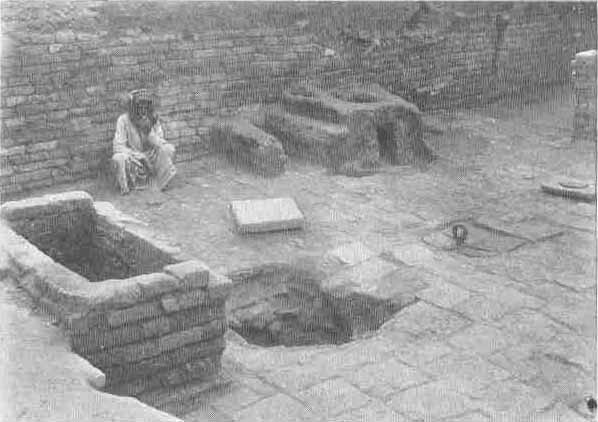
p. 176
taking away treasure which is yours but the wealth which your fathers tok out of Egypt." And Rehoboam died in the heathen practices of his father Solomon.
[Shishak was the first king of the XXIInd Dynasty and reigned about 20 years (947-928 B.C.): he was of Libyan origin. The Egyptian form of his name is SHASHANQ  , and it is found with his title "beloved of Amen" in a cartouche thus:
, and it is found with his title "beloved of Amen" in a cartouche thus:  .]
.]
And Abijah his son reigned after him and he destroyed Jerusalem with fornication and with heathen works--now, Melkâ, the mother of `Abhd-Shâlôm, was his mother--and he died in the heathen practices of his father.
And Asa his son reigned after him for forty years in Jerusalem. He did that which was good before the Lord, and he put away fornication from Jerusalem, and made an end of the heathen practices of his people, for he kept the commandments of God [Fol. 32b, col. 1]. And he drove them (i.e. the idolators) out of his palace (or, kingdom), and made them to be a mockery before all the people, because they [taught] the offering of sacrifices to idols. And Zerah of Judah went up against him, and God humbled him before Asa. And Asa died in righteousness like his father David.
p. 177
[NOTE.--The Book of Adam (iv. 8) says that Asaph (i.e. Asa) took his mother Anna, who was an adulteress, and cast her down from the roof of her house, and she died. Zerah, who is called Eleazar, is described as a "black king" who reigned at Endena. No mention of Zerah the Cushite has hitherto been found in the cuneiform or hieroglyphic inscriptions.]
And Jehosaphat his son reigned after him, and he walked in the ways of Asa his father, and he did that which was pleasing before God. And God was angry with him because he was a friend of the house of Ahab, and for this reason God did not permit him to bring out gold from Ophir. Now he made ships to send thither, and they were broken at Ezion Geber. He was thirty-two years old when he began to reign, and the name of his mother was `Azôbhâ (Azuba ?), the daughter of Shâlâh. And Jehosaphat died in his righteousness.
Joram reigned after him, and he was thirty-two years old [Fol. 32b, col. 2] when he began to reign; he reigned eight years in Jerusalem. He did not do what was pleasing before God, for he sacrificed at the altar of devils, and he died in his heathen practices.
[NOTE.--In the Book of Adam he is called Aram. Zambri made war upon him, and he died denying God.]
p. 178
Ahaziah his son reigned after him, and he was twenty-two years old when [he began] to reign; he lived for one year in Jerusalem, and did evil things before God in that year. Because of the wickedness and iniquity which he wrought, God delivered him into the hands of his enemies and they killed him. When he was dead his mother [Athaliah] killed all the royal children of the house of David, imagining that she would uproot the children of the Jews. The only person of the seed of the royal house whom she did not slay was Joash, whom Yôshba` (Jehosheba), the daughter of Joram, the son of Jehosaphat, carried away secretly and hid [Fol. 33a, col. 1] with her in her house.
[Reign of Ahab's sister.]
And the sister of Ahab reigned seven years in Jerusalem. And she polluted the city with fornication, for she commanded the women to play the whore without fear, and the men to commit adultery with the wives of their neighbours without incurring any penalty. And she herself committed fornication like Jezebel, and she adopted all the heathen practices of the house of Ahab in Jerusalem.
[Reign of Joash.]
And after seven years the children of Jerusalem considered whom they should make their king,
p. 179
and Jehoiada the priest gathered them together in the house of the Lord, in the temple which Solomon had built. And when the captains of thousands and the captains of hundreds had gathered together, Jehoiada the priest said unto them, "Whom say ye shall be king and sit upon the throne of David except [he be] a king and the son of a king?" And when he showed him [Fol. 33a, col. 2] to them they rejoiced with an exceedingly great joy. And the captains of thousands, and the captains of hundreds, and the "runners," and the messengers brought the kingdom to the house of the Lord, and the soldiers who were armed surrounded him on all sides; and Jehoiada the priest set him (i.e.Joash) upon the throne of David his father. And [Joash] was seven years old when [he began] to reign, and he reigned forty years in Jerusalem. And the name of his mother was Sûbhâ (Zibea) and she was from Beersheba. And Athaliah [the mother of Ahaziah] was killed. And Joash requited with evil the kindness which Jehoiada had done him, and after his death he shed the innocent blood of his sons. And Joash died, and Amaziah his son reigned after him.
Amaziah was twenty-five years old when he began to reign, and he reigned twenty-nine years in Jerusalem; and the name of his mother
p. 180
was Yâhô`adhân (Joadan). And Amaziah died, and [Fol. 33b, col. 1] Uzziah his son reigned after him.
Uzziah was sixteen years old when [he began] to reign, and he reigned fifty (sic) years in Jerusalem; and the name of his mother was Îkhânyâ (Jechalia). And he did that which was good before the Lord. Now, he made bold to go into the Holy of Holies, and he took the censer from the priest of God (Azariah), and burned incense in the temple of the Lord; and because he did this leprosy covered his face. And because Isaiah the prophet did not rebuke him, he was prevented from prophesying until Uzziah died. And Jotham his son reigned in his stead.
Jotham was twenty-five years old when [he began] to reign, and he reigned sixteen years in Jerusalem; and the name of his mother was Îrûshâ (Jerusa), the daughter of Zadok. And he did that which was good before the Lord, and he died and Ahaz his son reigned after him.
[Ahaz a vassal of the King of Assyria.]
Ahaz was twenty years old when [he began] to reign, and he reigned sixteen years in Jerusalem [Fol. 33b, col. 2]; and the name of his mother was `Aphin, the daughter of Levi. And he did that which was evil before the Lord, and he
p. 181
sacrificed to devils. Tiglath-Pileser, the king of Assyria, went up against him, and Ahaz wrote himself down in his letter as his servant, and the Assyrian held him in subjection. And Ahaz sent to the king of Assyria the gold and silver [which were in] the house of the Lord, [and in his days] the children of Israel were carried off into captivity. And the king sent for the men who had come from Babel, so that they might dwell in the land instead of the children of Israel, because they could kill the lions. And the king of Assyria sent to them Ôrî [Fol. 34a, col. 1] the priest, and he taught them the laws. And Ahaz died and Hezekiah his son reigned after him.
[NOTE.--The Assyrian king who conquered Ahaz was Tiglath Pileser III, who reigned from 745-727 B.C. In a list of the kings in the British Museum which were his tributaries we find--
 |
 |
 |
 |
 |
 |
 |
 |
 |
  |
| Ia- | u- | kha- | zi | (matu) | Ia- | u- | da- | ai | |
|
Ahaz [king of] the country of the Judeans. (Brit. Mus. K. 2751.) |
|||||||||
Tiglath Pileser's Babylonian name was PU-LU,  , which we find in the Bible under the form of "Pul." (See II Kings xv. 29; xvi. 7, 10; and I Chron. v. 26.)]
, which we find in the Bible under the form of "Pul." (See II Kings xv. 29; xvi. 7, 10; and I Chron. v. 26.)]
p. 182
[Hezekiah.]
Hezekiah was twenty-five years old when [he began] to reign, and he reigned twenty-nine years in Jerusalem; and the name of his mother was Akhi (Abhi ?), the daughter of Zechariah. And he did that which was pleasing before the Lord, for he smashed the altars, and he cut in pieces the serpent of brass which Moses made in the wilderness, because the children of Israel used to worship it, and he abolished heathen practices in Jerusalem.
In the fourth year of his reign, Shalmaneser, king of Assyria, came up and carried away captive the rest of the children of Israel, and he sent them into Media, beyond Babel.
[NOTE.--Tiglath Pileser III having conquered Syria carried away into captivity the Israelitish tribes of Reuben and Gad, and the half tribe of Manasseh. His successor Shelmaneser V,  (727-722 B.C.) attacked Hosea, king of Israel, and conquered him and, because he was an ally of the king of Egypt, carried him off into captivity.]
(727-722 B.C.) attacked Hosea, king of Israel, and conquered him and, because he was an ally of the king of Egypt, carried him off into captivity.]
And in the twentieth year of Hezekiah, Sennacherib, king of Assyria, came up and took all the cities and towns of Judah, but through the prayer of Hezekiah Jerusalem was saved.
p. 183
[NOTE.--Sennacherib,  , king of Assyria, 705-681 B.C., having brought Padi from Jerusalem and made him king of Ekron, then marched on to attack
, king of Assyria, 705-681 B.C., having brought Padi from Jerusalem and made him king of Ekron, then marched on to attack
 |
 |
 |
 |
 |
 |
 |
 |
 |
 |
  |
| Kha- | za- | ki- | a- | u- | (matu) | Ia- | u- | da- | ai | |
| "Hezekiah [king of] the country of the Judeans." | ||||||||||
He captured 46 of Hezekiah's strongholds, and brought out from them 200,150 people, and horses, mules, asses, camels, oxen, and innumerable sheep. He then shut up Hezekiah like a caged bird in
 |
 |
 |
 |
 |
 |
 |
 |
 |
  |
| Ur- | sa- | li- | im- | mu | ali | sharru- | ti- | su | |
| "Jerusalem the city of his sovereignty." | |||||||||
Hezekiah's soldiers deserted, and he sent his envoy to Nineveh to pay his tribute to Sennacherib, viz. 30 talents of gold, 800 talents of silver, precious stones, eye-paint, couches and chairs of ivory, hides, tusks, precious woods, and his daughters with their attendants and musicians.]
And Hezekiah became sick unto death [Fol. 34a, col. 2], and it was grievous unto him, and he wept. And there were certain men who blamed him, but why [his sickness] was grievous unto him they never troubled to acquaint themselves. Now the sorrow of Hezekiah [came upon him]
p. 184
because when he became sick unto death he had no son to reign after him. And when he looked with the eyes of his soul and saw that he had no son to reign after him, he was afflicted, and wept and said, "Woe is me! for I must die childless, and that blessing which hath been given [unto us] for six and forty generations hath been cut off by me this day. I have become the destroyer of the kingdom of David, and the succession of the kings of Judah hath been cut off this day." This was [the cause of] the sorrow of Hezekiah. And after he recovered from his sickness he waited fourteen years, and [then] Manasseh was born to him. And Hezekiah died in great content, and left a son to sit upon the throne of David [Fol. 34b, col. 1] his father.
[Manasseh.]
Manasseh was twelve years old when [he began] to reign, and he reigned fifty-five years in Jerusalem; and the name of his mother was Habhsîbhâh (Hephziba). He was a man who was more evil and iniquitous than all those who had lived before him; he builded altars to devils, and sacrificed to idols, and he filled Jerusalem with iniquity and provoked God to wrath. And because Isaiah the prophet rebuked him, he threatened him and sent men who were sons of iniquity, and they sawed Isaiah the prophet in
p. 185
twain with a saw between [two pieces of] wood, from his head downwards to his feet. And Isaiah was one hundred and twenty years old when they sawed him in twain, and he had been the prophet of God for ninety years. And Manasseh repented after he had slain Isaiah, and he put sackcloth on his body, and decreed fasting for himself, and he ate bread with tears all the days of his life because he had committed iniquity and had [Fol. 34b, col. 2] slain the prophet. And Manasseh died, and Ammon reigned after him.
Ammon was twenty-two years old when [he began] to reign, and he reigned two years in Jerusalem; and the name of his mother was Mashlemath. And Ammon did evil before the Lord, and he made his sons to pass through fire; he died, and Josiah his son reigned after him. Josiah was eight years old when he began to reign, and he reigned thirty-one years in Jerusalem; and the name of his mother was Yadhîdhâ (Jedida), the daughter of Azariah (Adaja ?), from Bezkath. And he did what was good before the Lord, and he walked in all the way wherein his father David had walked; and he turned aside neither to the right hand nor to the left. And Pharaoh, the "Lame" (i.e. Necho II) killed him, and Jehoahaz his son reigned after him.
p. 186
[NOTE.--Pharaoh Necho, king of Egypt 609-593 B.C., was the second king of the XXVlth Dynasty. His names as "King of the South and North" and "Son of Ra" are
 |
 |
|
| Uhem-a{dot-over}b-R¯a | N-Ka-u.] |
Jehoahaz was twenty-three years old when [he began] to reign, and he reigned three months in Jerusalem; and the name of his mother was Hamtâl, the daughter of [Fol. 35a, col. 1] Jeremiah from Lebhnâ. And he did what was evil before the Lord, even as Manasseh had done. And Pharaoh, the Lame, king of Egypt, took him prisoner in Diblath, in the land of Hamath, whilst he was king in Jerusalem, and he laid tribute on the land, one hundred talents of silver and ten talents of gold. And Pharaoh, the Lame, made Eliakim, the son of Jonah, king instead of Josiah his father, and he made his name to be Jehoiakim. And he carried away Jehoahaz, and he went to Egypt and died there. And Jehoiakim gave silver and gold to Pharaoh; he laid [the payment] of silver and gold on the land according to the word (i.e. command) of Pharoh's mouth. Every man, according to what it was right for him [to pay], brought silver and gold from the people of the land, according to the command of the mouth of Pharaoh, the Lame.
p. 187
Jehoiakim was twenty-five years old when [he began] to reign, and he reigned eleven [Fol. 35a, col. 2] years in Jerusalem; and the name of his mother was Zebhîdhâ, the daughter of Pedâyâ, from Ramah. And he did that which was evil before the Lord, even as his fathers had done. In his days Nebuchadnezzar, king of Babel, went up against Jerusalem, and Jehoiakim became his vassal for three years. Then he turned and rebelled against him, and the Lord stirred up bands of robbers against him because of his sins. And Jehoiakim slept with his fathers, and Jehoiachin his son reigned after him. And the king of Egypt did not come forth again out of his country; for the king of Babel captured all the land that belonged to the king of Egypt, from the river of Egypt to the river Euphrates.
Jehoiachin was eighteen years old when [he began] to reign, and he reigned three months in Jerusalem; and the name of his mother was Neheshtâ, the daughter of Elyâthân (Elnathan ?), from Jerusalem. And he did that which was evil before the [Fol. 35b, col. 1] Lord, even as his father had done. At that time Nebuchadnezzar, king of Babel, went up against Jerusalem, and the king of Babel took him with him in the eighth year of his kingdom. And he brought out from there all the treasure of the house of the Lord, and the treasure of the king' s house, and he
p. 188
carried off into captivity to Babel all [the people of] Jerusalem, and Jehoiachin, and his mother, and his wives, and his nobles; and the king brought captive to Babel all the men who had made war. And the king of Babel made Methanyâ, the uncle [of Jehoiachin] king in his stead, and he called his name "Zedekiah."
[The Capture of Jerusalem.]
Zedekiah was twenty years old when [he began] to reign, and he reigned eleven years in Jerusalem; and the name of his mother was Hamtâl, the daughter of Jeremiah, from Libnah. And he did that which was evil before the Lord, even as did Jehoiakim, and the wrath of the [Fol. 35b, col. 2] Lord was (i.e. fell upon) Jerusalem. And Zedekiah rebelled against the king of Babel, and in the ninth year of his kingdom Nebuchadnezzar, king of Babel, came against Jerusalem, and the city was fettered with affliction (i.e. besieged) until the eleventh year of king Zedekiah. And the city was rent open (i.e. its wall was breached), and all the mighty men of war fled from the city by night by way of the plain. And the soldiers of the Chaldeans pursued the king, and they overtook him on the plain of Jericho, and all his soldiers were driven away from him; and the Chaldeans captured Zedekiah and took him up to the king of Babel at
p. 189
Debhlath (Riblah), and he passed judgment upon him. And the king of Babel slew the sons of Zedekiah the king before his eyes, and he blinded the eyes of Zedekiah, and bound him in chains, and carried him to Babel [Fol. 36a, col. 1]. And Simeon the high priest, because he had freedom of speech with the commander of the [Chaldean] army, made entreaty to him, and the commander of the army gave him all the books of the Scriptures and did not burn them; and Simeon the high priest gathered them together and cast them into a pit (or dry well). And Jerusalem was laid waste and made desolate, and no man remained therein except Jeremiah, the Prophet, who sat and raised lamentations over it for twenty years. And Jeremiah, the Prophet, died in Samaria, and the priest Ûr buried him in Jerusalem, according to the oath which the prophet made him to swear.
Now up to the time of the destruction of Jerusalem the Hebrew, Greek, and Syrian writers were in possession of the truth, and they were able to produce the registers of the genealogies of the tribes and the people. But from the destruction of Jerusalem and onwards there has been no truth in their writings, except as regards the heads of the tribes (i.e. the Patriarchs) [Fol. 36a, col. 2], and they are unable to prove whence the succession of the priests took its origin.
p. 190
[Jehoiachin.]
And Jehoiachin was bound in prison for thirty-seven years, and after he came forth from prison he took to wife Gûlîth, the daughter of Eliakim, and he begot by her in Babel Shalathiel (Salathiel); and Jehoiachin died in Babel. And Salathiel took to wife Hetbath, the daughter of Halkânâ, and he begot by her Zûrbâbhel (Zerubbabel), who took to wife Malkath, the daughter of Ezra the scribe; but no son was born to him by her in Babel. In the days of Zerubbabel, the prince of Judah, Cyrus the Persian reigned in Babel. [A reproduction of a sculptured relief of Cyrus is given on Plate I. The official account of his conquest of Babylon is found on a baked clay cylinder now in the British Museum. See Plate II.]
[Cyrus.]
And Cyrus took to wife the daughter of Salathiel, the sister of Zerubbabel, and he took her to wife according to the law of the Persians, and made her [his] queen. And she entreated Cyrus to bring about the return of the children of Israel [to Jerusalem]. And inasmuch as Zerubbabel was her brother, she was very insistent about [Fol. 36b, col. 1] the return [to Jerusalem] of those who had been led away into captivity. Now Cyrus loved his wife as he loved himself, and he did
p. 191
for her what she wished. And he sent forth heralds into all the land of Babel, ordering all the children of Israel to gather themselves together. And when they were gathered together Cyrus said unto Zerubbabel, his wife's brother, "Rise up, and take with thee all the children of thy people, and go up to Jerusalem in peace; and [re]build the city of thy fathers, and dwell and reign therein. And because Cyrus brought about the return of the children of Israel [to Jerusalem], God said, "I have taken my servant Cyrus by his right hand" (Isa. xliv. 28; xlv. 1). And the name of Cyrus was called "My shepherd, the anointed of the Lord," because his seed was received into the seed of David through Meshayyanath, the sister of Zerubbabel, whom he had taken to wife. And the children of Israel went up from Babel, and Zerubbabel became king over them; and Joshua, the son of Yôzâdâk, the son of Aaron, was high priest, even as the angel showed Zechariah the prophet, and said unto him, "These are the sons of the oil of consecration."
And the people of the captivity went up in the second year of Cyrus, and the FIFTH THOUSAND YEARS CAME TO AN END.
-
Urantia Book, 44:0.11 - The Celestial Artisans
Never in your long ascendancy will you lose the power to recognize your associates of former existences. Always, as you ascend inward in the scale of life, will you retain the ability to recognize and fraternize with the fellow beings of your previous and lower levels of experience. Each new translation or resurrection will add one more group of spirit beings to your vision range without in the least depriving you of the ability to recognize your friends and fellows of former estates.
-
Princess Bride 1987 Wallace Shawn (Vizzini) and Mandy Patinkin (Inigo Montoya)
Vizzini: HE DIDN'T FALL? INCONCEIVABLE.
Inigo Montoya: You keep using that word. I do not think it means what you think it means. -
Urantia Book, 117:4.14 - The Finite God
And here is mystery: The more closely man approaches God through love, the greater the reality -- actuality -- of that man. The more man withdraws from God, the more nearly he approaches nonreality -- cessation of existence. When man consecrates his will to the doing of the Father's will, when man gives God all that he has, then does God make that man more than he is.
-
Urantia Book, 167:7.4 - The Talk About Angels
"And do you not remember that I said to you once before that, if you had your spiritual eyes anointed, you would then see the heavens opened and behold the angels of God ascending and descending? It is by the ministry of the angels that one world may be kept in touch with other worlds, for have I not repeatedly told you that I have other sheep not of this fold?"
-
Urantia Book, Foreword - 0:12.12 - The Trinities
But we know that there dwells within the human mind a fragment of God, and that there sojourns with the human soul the Spirit of Truth; and we further know that these spirit forces conspire to enable material man to grasp the reality of spiritual values and to comprehend the philosophy of universe meanings. But even more certainly we know that these spirits of the Divine Presence are able to assist man in the spiritual appropriation of all truth contributory to the enhancement of the ever-progressing reality of personal religious experience—God-consciousness.
-
Urantia Book, 1:4.3 - The Mystery Of God
When you are through down here, when your course has been run in temporary form on earth, when your trial trip in the flesh is finished, when the dust that composes the mortal tabernacle "returns to the earth whence it came"; then, it is revealed, the indwelling "Spirit shall return to God who gave it." There sojourns within each moral being of this planet a fragment of God, a part and parcel of divinity. It is not yet yours by right of possession, but it is designedly intended to be one with you if you survive the mortal existence.
-
Urantia Book, 1:4.1 - The Mystery Of God
And the greatest of all the unfathomable mysteries of God is the phenomenon of the divine indwelling of mortal minds. The manner in which the Universal Father sojourns with the creatures of time is the most profound of all universe mysteries; the divine presence in the mind of man is the mystery of mysteries.
-
Urantia Book, 1:4.6 - The Mystery Of God
To every spirit being and to every mortal creature in every sphere and on every world of the universe of universes, the Universal Father reveals all of his gracious and divine self that can be discerned or comprehended by such spirit beings and by such mortal creatures. God is no respecter of persons, either spiritual or material. The divine presence which any child of the universe enjoys at any given moment is limited only by the capacity of such a creature to receive and to discern the spirit actualities of the supermaterial world.
-
Urantia Book, 11:0.1 - The Eternal Isle Of Paradise
Paradise is the eternal center of the universe of universes and the abiding place of the Universal Father, the Eternal Son, the Infinite Spirit, and their divine co-ordinates and associates. This central Isle is the most gigantic organized body of cosmic reality in all the master universe. Paradise is a material sphere as well as a spiritual abode. All of the intelligent creation of the Universal Father is domiciled on material abodes; hence must the absolute controlling center also be material, literal. And again it should be reiterated that spirit things and spiritual beings are real.
-
Urantia Book, 50:6.4 - Planetary Culture
Culture presupposes quality of mind; culture cannot be enhanced unless mind is elevated. Superior intellect will seek a noble culture and find some way to attain such a goal. Inferior minds will spurn the highest culture even when presented to them ready-made.
-
Urantia Book, 54:1.6 - True And False Liberty
True liberty is the associate of genuine self-respect; false liberty is the consort of self-admiration. True liberty is the fruit of self-control; false liberty, the assumption of self-assertion. Self-control leads to altruistic service; self-admiration tends towards the exploitation of others for the selfish aggrandizement of such a mistaken individual as is willing to sacrifice righteous attainment for the sake of possessing unjust power over his fellow beings.
-
Urantia Book, 54:1.9 - True And False Liberty
How dare the self-willed creature encroach upon the rights of his fellows in the name of personal liberty when the Supreme Rulers of the universe stand back in merciful respect for these prerogatives of will and potentials of personality! No being, in the exercise of his supposed personal liberty, has a right to deprive any other being of those privileges of existence conferred by the Creators and duly respected by all their loyal associates, subordinates, and subjects.
-
Urantia Book, 54:1.8 - True And False Liberty
There is no error greater than that species of self-deception which leads intelligent beings to crave the exercise of power over other beings for the purpose of depriving these persons of their natural liberties. The golden rule of human fairness cries out against all such fraud, unfairness, selfishness, and unrighteousness.





